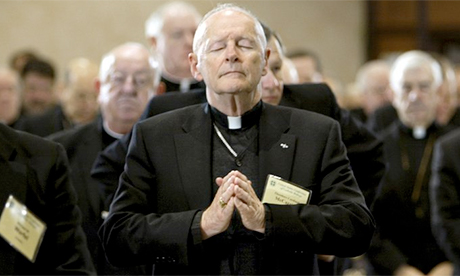The Vatican’s report into ex-Cardinal Theodore McCarrick has raised uncomfortable questions the Holy See will have to confront going forward, chief among them what it’s going to do about current and future clergy who abuse their power to sexually abuse adults.
Priests, lay experts and canon lawyers alike say the Vatican needs to revisit how the church protects its seminarians, nuns and even rank-and-file parishioners from problem bishops and cardinals, who for centuries have wielded power and authority with few — if any — checks or accountability.
McCarrick was only investigated and defrocked by Pope Francis because a former altar boy came forward in 2017 to report the prelate had groped him when he was a teenager in the 1970s. It was the first time someone had claimed to be abused by McCarrick while a minor, a serious crime in the Vatican’s in-house legal system.
And yet the bulk of the Vatican’s 449-page forensic study into the McCarrick scandal released Tuesday dealt with the cardinal’s behaviour with young men: the seminarians whose priestly careers he controlled and who felt powerless to say no when he arranged for them to sleep in his bed.
The report found that three decades of bishops, cardinals and popes dismissed or downplayed reports of McCarrick’s misconduct with the young men.
Confidential correspondence showed they repeatedly rejected the information outright as rumour, excused it as an “imprudence” or explained it away as the result of McCarrick having no living relatives.
McCarrick’s friends and superiors went to enormous lengths to find ways to claim his behaviour wasn’t necessarily sexual, couldn’t be proven and would cause a scandal if it ever went public.
Their decades-long reflex to turn a blind eye was evidence of the church’s old boys culture of silence, clerical privilege and protection of reputations at all cost.
No one ever thought about the effect of his behaviour on the young men.
The report faulted in particular St. John Paul II, who appointed McCarrick archbishop of Washington and later made him a cardinal despite having commissioned an inquiry that confirmed he bedded his seminarians. The report recommended he not be promoted.
But John Paul gave McCarrick the most influential position in the U.S. church, which, coupled with his role as a major U.S. fundraiser, meant the cardinal wielded enormous power as he hobnobbed with presidents, prime ministers and three popes.
“The reason we had a McCarrick was because he pulled so much power to himself, relatively quickly,” said the Rev. Desmond Rossi, a former seminarian under McCarrick who was interviewed for the report.
“I think the church has to look at the authority and power that people are given: How do we guarantee that it’s used in a healthy way?”
The question for the church is also a legal one, just as it is in the secular sphere. Vatican and U.S. Catholic leaders had known since the 1990s that McCarrick slept with his seminarians. But that wasn’t a firing offence under the church’s canon law — then or now.
Since McCarrick’s seminary victims weren’t minors, they weren’t considered victims at all, and in those years even priests who repeatedly raped children had their crimes covered up.
McCarrick rose to the heights of the Catholic hierarchy merely bothered by occasional “rumours” that he had been “imprudent” with the young men.
“It does get down to this idea that somehow when someone turns 18, a) they’re no longer vulnerable, and b) that they have the ability to protect themselves,” said David Pooler, a professor of social work at Baylor University and an expert in clergy sexual abuse of adults.
“And what I have learned from my research is that that’s simply not true: that there’s nothing magical about becoming an adult and being able to then protect oneself in a vulnerable place,” he said.
Pooler said a seminarian is really in no position to offer meaningful, free consent to any sexual activity with his bishop, since his bishop has all the power in the relationship. A bishop or seminary rector determines whether the seminarian can continue in his studies, is ordained a priest, or is assigned to a good parish.
“Only when there is sort of equal freedom and kind of equal power in the relationship could there ever possibly be consent,” Pooler said. “And that’s just impossible between a priest and someone who’s in seminary, or a priest and someone who’s just in their congregation or parish.”
The Vatican has long sought to portray any sexual relations between priests and adults as sinful but consensual, focusing in recent years only on protecting minors and “vulnerable adults” from predator priests. The Vatican’s legal norms have defined “vulnerable” people as those who are disabled or consistently lack the use of reason.
Only in the past year or so, amid the #MeToo reckoning, has the Vatican even admitted publicly that religious sisters can be sexually abused by priests, bishops or even their own mother superiors. The McCarrick scandal now stands as a case study of how seminarians can be exploited and abused by the men who hold power over them.
“People have the tendency to believe the one who is in power, and not the one who is powerless,” said Karlijn Demasure, director of the Centre for Safeguarding Minors and Vulnerable Persons at Saint Paul University in Ottawa, Canada. “
And that’s the whole change in culture that has to happen: that one has to listen to the vulnerable and not to the ones who are in power.” Continue reading
Additional readingNews category: Analysis and Comment.




